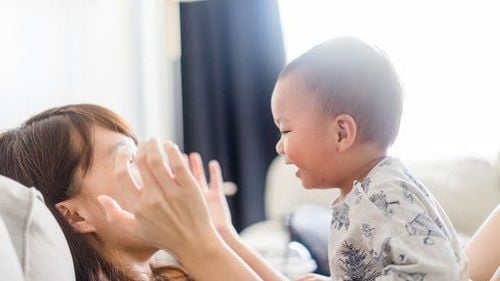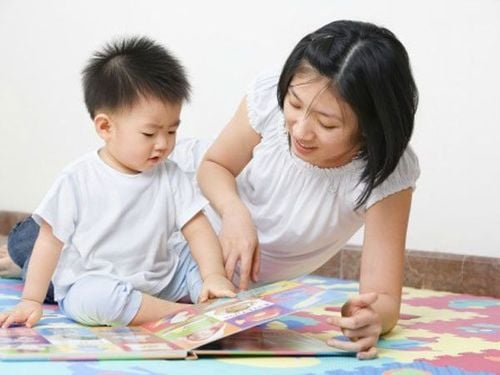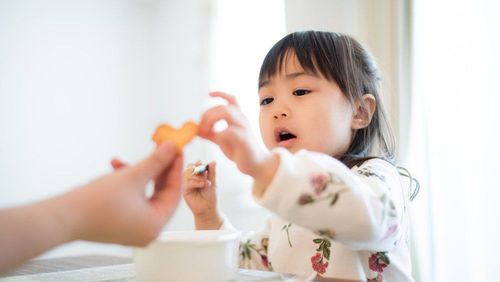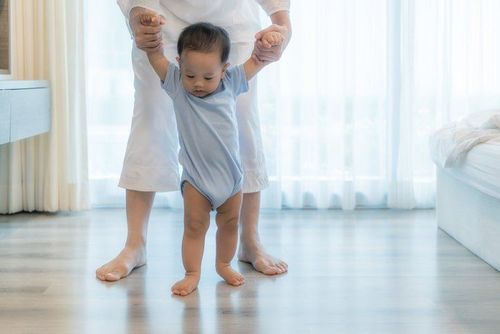This is an automatically translated article.
Article by Master Nguyen Thi Yen - Pediatric Speech Therapist - Vinmec Time City International HospitalIt is undeniable that play plays an extremely important role in both physical and mental development. children's quality, thinking ability, language skills, social skills, and problem solving. There are many parents who find it difficult to play with their children, from choosing toys, coming up with play ideas, to instructing children how to play appropriately... This article provides some insights. Knowledge of the development characteristics of 2-year-old children and suggestions for parents to play with their children at home, help encourage children to develop in the best way.
1. How do 2-year-olds develop?
1.1 Language Children can understand at least 100 words (mainly nouns and verbs) and use at least 50 simple words. Children frequently imitate new words and begin to use 2-word phrases. Children use gestures and words during play. Children recognize and correctly identify 3-5 body parts when asked. Children love to hear stories and can listen for about 5 minutes. Children recognize actions in books and pictures. Children are able to follow 2-step instructions that are related to each other. Example: “Pick up the toy and put it away”. Children will begin to use more pronouns such as: Son, grandchild, em, etc. Each child's learning and speaking speed is different. Boys tend to speak later than girls. At 2 years old, children understand more than they can say.>>> Develop baby's senses through play
1.2 Social skills Children respond faster when someone calls their name, for example: Turning head, smiling, talking,... interested and able to maintain eye contact with others. Children love to explore different environments e.g. new playground and can join other children to play. Children know how to look in the direction of an adult's finger. Children observe and imitate the actions of adults and older children. At this age, children often think that everything is theirs. Concepts such as: Sharing, in turn, do not have much meaning to children. Therefore, children will tend to show some challenging behaviors when they don't get what they want such as: Throwing things, crying, yelling,...
>>> 3 ways to help young children build language skills language and literacy
1.3 About play skills Children love to play interactive games, eg: Likes being picked up and turned. Children love to play with new toys in different ways. Children like to play with a variety of toys with different textures such as: soft, rough, ... Children like to play cause-effect toys, musical toys. Children love to sit and read books or listen to stories. Children begin to perform some pretend play activities such as: Holding the doll, feeding, putting it to sleep. >>> Children 16-18 months and language development ability

Trẻ 2 tuổi thường thích những trò chơi có sự tương tác, giao tiếp
2. Strategies for playing with 2-year-olds
To play effectively with children, in addition to finding and organizing appropriate games, parents should use some of the following strategies:Use simple 2-3 word phrases, speak clearly. Repeat what your child says and add information to it. Example: Your child says “car goes”, you can say “red car go.” Listen, be patient, and acknowledge all of your child's efforts to communicate, even if he doesn't speak clearly. Teach new words and provide opportunities for children to use those new words in everyday communication. Reading is a great idea to help you teach your child new words, such as naming objects, pictures, actions in books. Take advantage of every opportunity to communicate and teach your child in all activities of daily living. >>> What are fine motor skills? How to develop early for children?
3. Suggest some simple activities to play with 2-year-olds
Play peek-a-boo: You can stand behind tables, chairs, curtains or cover your face with a towel. While playing, use an excited voice to comment and ask questions such as: “Who is it?”; “Where are you hiding?”; "I found you." Play with hand puppets: You draw faces on your fingers or use small puppets to wear on your fingers. Then you can sing Finger Family or hide your fingers and ask your child: “Where are my fingers?”; “Is your face happy or sad”; “What will your cat friends say?”... Stacking toys: As you play, you teach your child to recognize his or her turn and that of others by saying “mom’s turn”, “my turn” ". At the same time, you can also comment on the activity you and your child are doing. For example: “Mommy built this tall house”, “oh no, the pink puzzle has fallen”,... Sing and read rhymes: You can guide your child to play some simple games. such as “Chi chi staggered”, “Spider weaves a web”... While playing, you teach your child to use gestures such as: Pressing hands, pointing fingers and learning to speak/singing tail stroking along with the lyrics of songs, rhymes and rhymes. knife. Play with animals: Use pictures, animal models or puzzle pieces to teach your child. During play, ask your child about animal sounds, for example, “what would a cow make?” Or hide toys and encourage your child to look for them.
Khi chơi với trẻ, bạn có thể bắt đầu bằng 1 số trò như ú òa, hát các bài đồng dao,...
Play with the ball: You can create many different types of ball play depending on your child's interests and preferences such as: Roll the ball, throw the ball, kick the ball, hide the ball behind your back,... While playing, you instruct your child to comment on his or her turn (e.g. “Your turn,” “Mom’s turn”) or talk about what he or she is doing with the ball (e.g. “Throw the ball,” “ball go up,” "ball goes down",...). Play with soap bubbles: Play slowly and make sure your child notices you before you blow the balloon. In the first few turns, you can say “prepare...blow” and blow really fast. After your child gets used to and interested in the activity, slow down and say “get ready...” then wait for your child to say “blow” or “ball” before you blow. When the balloons go up, you can comment “too many balls”, “squeeze...the balls are broken”, “all the balls are out”,... Playing with dolls and teddy bears: Your child will imitate the fake play pretend with these toys (eg: Pretend to feed the doll, put the doll to sleep,...). During play, encourage your child to do some pretend play on their own. For example: You say "The bear is hungry" and wait to see if he knows how to feed the bear, if he doesn't, please guide him or make a model for him to know how to do; If your child can do it, praise “oh, you already fed the Bear, Thank you.” Also, encourage your child to imagine one object as another (example: Imagine a napkin as a blanket for a Bear). >>> Print books or e-books: Which is good for children?
Sensory activities: Organize and guide your child to play with toys of different textures and materials such as: Sand, rice, water, cotton,... While playing, you can teach your child to feel about materials such as: Hard, soft, rough, ... Play activities related to movement such as: Sitting on swings, hugging and turning, rolling the ball on your stomach,... Reading books: You choose books Flip-flops come in a variety of materials. When you read a book, you teach your child new words, teach color and shape recognition, practice counting, and name objects/images in the book. Play guess the name of the object: You put the toy in a box, then guide your child to find, feel and guess the name of the object he is holding. Create an album “Children’s Book” with pictures of family members, toys, gadgets, and favorite activities. Some safe toys should be for 2-year-olds such as: toy cars, dolls, teddy bears, animal models, dish sets, teapots, sand play sets, drop blocks, some musical instruments, bubbles, soap bubbles,...
4. Signs that you should be concerned about your child's difficulties at 2 years old
Children do not use gestures and gestures. Children do not use 2-word phrases while communicating. Children do not know what to do with common objects such as phones, spoons, ... Children do not imitate the actions and words of others. The child is unable to follow simple instructions related to activities of daily living. Children gradually lose the language and communication skills, cognition,... that they had before.
Nếu nhận thấy trẻ không bắt chước mình khi cùng chơi trò chơi, bạn cần theo dõi trẻ kỹ càng
Gathering a team of leading pediatricians: including leading experts with high professional qualifications ( professor, associate professor, doctorate, master), experienced, worked at major hospitals such as Bach Mai, 108.. The doctors are well-trained, professional, have a heart - a vision. Understanding young psychology. In addition to domestic pediatric specialists, the Department of Pediatrics also has the participation of foreign experts (Japan, Singapore, Australia, USA) who are always pioneers in applying the latest and most effective treatment regimens. . Comprehensive services: In the field of Pediatrics, Vinmec provides a series of continuous medical examination and treatment services from Newborn to Pediatric and Vaccine,... according to international standards to help parents take care of their baby's health from birth to childhood. Advanced techniques: Vinmec has successfully deployed many specialized techniques to make the treatment of difficult diseases in pediatrics more effective: neurosurgery - skull, stem cell transplant blood in cancer treatment. Professional care: In addition to understanding children's psychology, Vinmec also pays special attention to the children's play space, helping them to play comfortably and get used to the hospital's environment, cooperate in treatment, improve the efficiency of medical treatment.
Please dial HOTLINE for more information or register for an appointment HERE. Download MyVinmec app to make appointments faster and to manage your bookings easily.
References: asha.org, childdevelopment.com.au












